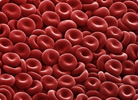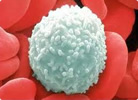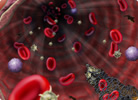Leukemia
LEUKEMIA
LEUKEMIA
General features
Leukemia is a cancer of the blood cells. Most blood cells are formed in the bone marrow. In the case of leukemia, immature blood cells become cancerous. These cells do not work as they should and congested to healthy blood cells in the bone marrow.
The different types of leukemia depends on the type of blood cell that becomes cancerous. For example, lymphoblastic leukemia is a cancer of the lymphoblasts (white blood cells that fight infection). White blood cells are the most common type of blood cell that becomes cancerous. However, red blood cells (cells that carry oxygen from the lungs to the body) and platelets (blood clotting cells) may also be converted into cancer.
Leukemia is more common in adults over 55 years, but is also the most common cancer in children under 15 years.
Leukemia can be acute or chronic. Acute leukemia is a fast-growing cancer usually gets worse quickly. Chronic leukemia is a slow-growing cancer that slowly gets worse over time. The treatment and prognosis of leukemia depends on the type of blood cell affected and the leukemia is acute or chronic.
The different types of leukemia depends on the type of blood cell that becomes cancerous. For example, lymphoblastic leukemia is a cancer of the lymphoblasts (white blood cells that fight infection). White blood cells are the most common type of blood cell that becomes cancerous. However, red blood cells (cells that carry oxygen from the lungs to the body) and platelets (blood clotting cells) may also be converted into cancer.
Leukemia is more common in adults over 55 years, but is also the most common cancer in children under 15 years.
Leukemia can be acute or chronic. Acute leukemia is a fast-growing cancer usually gets worse quickly. Chronic leukemia is a slow-growing cancer that slowly gets worse over time. The treatment and prognosis of leukemia depends on the type of blood cell affected and the leukemia is acute or chronic.
Gerardo Garcia Peralta . (2010). generalidades de la leucemia . 5/10/2015, de leucemia Sitio web: http://www.cancer.gov/espanol/tipos/leucemia
Etiology of leukemia
The indiscriminate use of X-rays and some drugs, especially in children and pregnant women. Severe bad nutrition, excessive consumption of refined carbohydrates (especially in children), excessive water fluoridation or salt, thyroid malfunction, vitamin D deficiency, iron, vitamin B12 and folic acid, chronic viral infections, hereditary propensity.
Symptoms:
paleness
purple bleeding fever
increased joint pain vulumen
abdominal pain
Leukemia almost always occurs as a mixture of several basic syndromes: anemic (the most common), fever, bleeding, tumor and pain (bone). In this case series was 66% pale, half of them also had a fever and was bleeding 1/3; in 18 cases it was associated with bone pain and 10 to volume increases. However there were 14 patients whose only symptom was pale, being in them very important to evaluate physical examination and blood count. Fever is a common symptom and evidence in this review that the analysis of blood count is very important because 60 cases of febrile neutropenia were 42, 17 and one blasts presence of anemia. In 4 of these 60 children the fever was the only symptom and all the blood count showed neutropenia.
personal opinion:
It is important to know, which causes this disease and avoid bad avitos, and must identify the symptoms, to prevent leukemia, thanks to early detection can be achieved by a treatment to help eliminate the disease. today there espesificos treatments which allows the disease does not progress and the sick person can get healthy

bibliography
Myriam Campbell B. (6/1999). leucemia etiologia y síntomas . 7/10/2015, de scielo Sitio web: http://www.scielo.cl/scielo.php?pid=S0370-41061999000400004&script=sci_arttext
8/10/2015
The blood components
Red blood cells
Also called erythrocytes. They are most numerous blood cells. They are responsible for transporting oxygen from the lungs to other tissues. The protein found inside and linking oxygen is called hemoglobin. Hemoglobin is red and gives this color to blood.

White Blood Cells
Also they called leukocytes. They concerned with defending the body against attack by bacteria, viruses, parasites and fungi.

Platelets or thrombocytes
Cell fragments are involved in protecting the wall of blood vessels, forming a "platelet plug" to prevent bleeding at the site of injury and produce various substances that help the healing of wounds.

plasma
It is the liquid part of the blood and is very rich in proteins, among which stand out as the most important: albumin, coagulation factors and immunoglobulins

personal opinion
Today they speak of blood components, because during the course of lecucemia to take, we'll be talking a lot about these Temino, and so will be much easier to understand the subject of the talk, mensiono leucositos, red blood cells, platelets and plasma, likewise put its function where the importance of this is shown, I hope you like this articuilo which is summarized but the information is understandable and clear.
Fundació Banc de Sang . (2012). que es la sangre . 8/10/2015, de dona sangre Sitio web: http://www.donasang.org/que-es-la-sang/es_els-components.html
Etiology of leukemia
The indiscriminate use of X-rays and some drugs, especially in children and pregnant women. Severe bad nutrition, excessive consumption of refined carbohydrates (especially in children), excessive water fluoridation or salt, thyroid malfunction, vitamin D deficiency, iron, vitamin B12 and folic acid, chronic viral infections, hereditary propensity.
Symptoms:
paleness
purple bleeding fever
increased joint pain vulumen
abdominal pain
Leukemia almost always occurs as a mixture of several basic syndromes: anemic (the most common), fever, bleeding, tumor and pain (bone). In this case series was 66% pale, half of them also had a fever and was bleeding 1/3; in 18 cases it was associated with bone pain and 10 to volume increases. However there were 14 patients whose only symptom was pale, being in them very important to evaluate physical examination and blood count. Fever is a common symptom and evidence in this review that the analysis of blood count is very important because 60 cases of febrile neutropenia were 42, 17 and one blasts presence of anemia. In 4 of these 60 children the fever was the only symptom and all the blood count showed neutropenia.
personal opinion:
It is important to know, which causes this disease and avoid bad avitos, and must identify the symptoms, to prevent leukemia, thanks to early detection can be achieved by a treatment to help eliminate the disease. today there espesificos treatments which allows the disease does not progress and the sick person can get healthy

bibliography
Myriam Campbell B. (6/1999). leucemia etiologia y síntomas . 7/10/2015, de scielo Sitio web: http://www.scielo.cl/scielo.php?pid=S0370-41061999000400004&script=sci_arttext
8/10/2015
The blood components
Red blood cells
Also called erythrocytes. They are most numerous blood cells. They are responsible for transporting oxygen from the lungs to other tissues. The protein found inside and linking oxygen is called hemoglobin. Hemoglobin is red and gives this color to blood.

White Blood Cells
Also they called leukocytes. They concerned with defending the body against attack by bacteria, viruses, parasites and fungi.

Platelets or thrombocytes
Cell fragments are involved in protecting the wall of blood vessels, forming a "platelet plug" to prevent bleeding at the site of injury and produce various substances that help the healing of wounds.

plasma
It is the liquid part of the blood and is very rich in proteins, among which stand out as the most important: albumin, coagulation factors and immunoglobulins

personal opinion
Today they speak of blood components, because during the course of lecucemia to take, we'll be talking a lot about these Temino, and so will be much easier to understand the subject of the talk, mensiono leucositos, red blood cells, platelets and plasma, likewise put its function where the importance of this is shown, I hope you like this articuilo which is summarized but the information is understandable and clear.
Fundació Banc de Sang . (2012). que es la sangre . 8/10/2015, de dona sangre Sitio web: http://www.donasang.org/que-es-la-sang/es_els-components.html

andrea this is the topic that touched you explain "the diseases" or adolescent pregnancy
ResponderBorrar